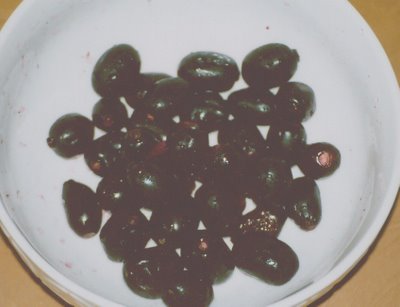 Summer is heaving one of its last breaths, but before the rains come, we get a downpour of purple globules that stain the walkways and make birds and bats a-flutter.
Summer is heaving one of its last breaths, but before the rains come, we get a downpour of purple globules that stain the walkways and make birds and bats a-flutter.I noticed first the splattered fruits on the pavement, and perhaps a pelt or two on my back, which made me look up at the fruit-heavy, humongous tree in front of both our gate and the gate where we stay in Cavite, before I realized it's lómboy time.
Lómboy (duhat, black plum/Java plum, jambolan, Indian blackberry, Syzygium Cumini Skeels) trees grow wild, relying on seed dispersal by birds. They are not cultured or cultivated for fruit, but nonetheless are so productive that when they are in season both man and beast can share in the abundance, with quite a few to spare for the usual pavement staining.
The fruit buds in elongated globules in light green color, turning to magenta and dark purple as it ripens, then on to almost black, which signals that it is ready to eat. That, is, if it doesn't pre-empt you and lets itself fall voluntarily to the ground even before you thought of looking for that tall, netted pole.
It is difficult to keep up with the fruits ripening, really, because they grow in clusters in every tree twig and branch, and ripen almost all at the same time.
When properly ripened, they are very sweet, with a slight astringence. The large globules protrude through your cheeks, especially when trying to get to the flesh around the big seeds with your tongue and teeth.
It is easy to tell who has taken the liberty to harvest that tree outside the fence - the tell-tale violet tongues and lips are good enough confessions. Of course, with the profusion, everybody is forgiven, in the spirit of community.
Eating lómboy is somehow not complete without the ritual kalóg-kalóg - putting the slightly firm berries in a bowl, sprinkling some salt in, covering the bowl with a plate, and proceeding to gleefully shake the bowl up and down.

The kalóg-kalóg bruises the berries, rendering the flesh soft and juicing them up a bit. This takes care of fruit still tart and astringent, making them readily edible without waiting for a few more days for them to ripen fully.
Of course this is not necessary for fully ripe fruits, which are so sweet it seems a sin to add salt to them. This is the only way I know how to eat the fruit, but it is commercially made into wine and other distilled liquors, and in other countries the juice is extracted and processed, to make into vinegar, tarts, sauces and jams.
Kalóg-kalóg is a time-honored ritual for me and probably for most Filipinos, but I recently learned that in other Asian countries, lómboy is a revered, sacred tree, and is planted near Hindu temples.
I have always known, though, that lombóy has been claimed to control diabetes, but this involves not the fruit itself but the seeds and the leaves, which, when boiled, are also potent in curing dysentery. The blossoms are also a good source of nectar for the bees to make into honey. If only for these, and especially for these, lómboy deserves my respect.
Related Post
The View from Below a Duhat Treet
8 comments:
oh i remember this kalog-kalog as you put it...but honestly, i am more of a siniguelas fan! i was lucky enough to have some during the trip! yum! one thing i missed though was lanzones! wrong season i guess...pero parang gusto ko tuloy ng duhat ngayon!
I miss lomboy. That was a childhood old time favorite. I love lanzones and sineguelas(sarguelas in ilocano). I wish they sell those in asian store. Fortunately I've tasted santol from Island Pacific oriental market.
Hello, Statesiders, according to this fact sheet, http://www.hort.purdue.edu/newcrop/morton/jambolan.html, duhat is cultivated in Santa Barbara, California, as well as in Puerto Rico and in most countries in South America. The US variety should be close to ours, since the seeds came from the Philippines.
Sineguelas coming up!
i love lomboy too, specially when you prepared it through your kalog-kalog secret way of making it juicy. most of all the stem or the bark of it when you boiled at least 30 minutes is a best cure for diabetes.
Hi Francis, yes we ate the fruit knowing it's good for diabetes. We didn't have the disease, but we believed in its power of prevention! ;-)
missing those fruits..we have lomboy tree infront of our house and its so nice to eat in a tree mismo kasi masarap pag fresh..tsaka we dry the leaves to make a roll for tobacco..nice smell..old people using it.
wow, I didn't know you could smoke lomboy leaves. thanks!
Thanks for sharing this informative post, really appreciate it. James Ferry MD
Post a Comment